The garden birdbaths attract many birds and vervet monkeys too, plus of course insects, such as bees and wasps. I have also seen geckoes venturing out to drink from the rim. The birdbaths are especially heavily used during the winter, which is our dry season.
These photos were all taken at one of the garden birdbaths during the past two days – that is Wednesday and Thursday of this week. Unlike during the summer, hardly any of the birds actually bathed while visiting – they seemed intent only on stopping by to drink.

The olive thrush is a particularly elegant visitor, elevating its bill to swallow while keeping a keen eye on the surroundings. Olive thrushes have an imposing presence and usually have the birdbath all to themselves.
In order to be able to photograph the visitors to the birdbath, I made a temporary hide (or blind) by attaching (using clothes pegs) some fabric to the nearby fence of the cats’ garden, leaving a porthole-style opening to look through. I sat inside the cat’s garden and for the most part managed to avoid the fence wires with the camera when I took these photos through the fence. The cats took this process in their stride and indulged in a little bit of bird watching through the fence too.

The most colourful and spectacular visitor by far is the purple-crested turaco (loerie).

Usually quite shy about coming down to drink, the ‘hide’ seemed to make these usually wary purple-crested turacos relaxed about drinking even though I think they knew that I was there.
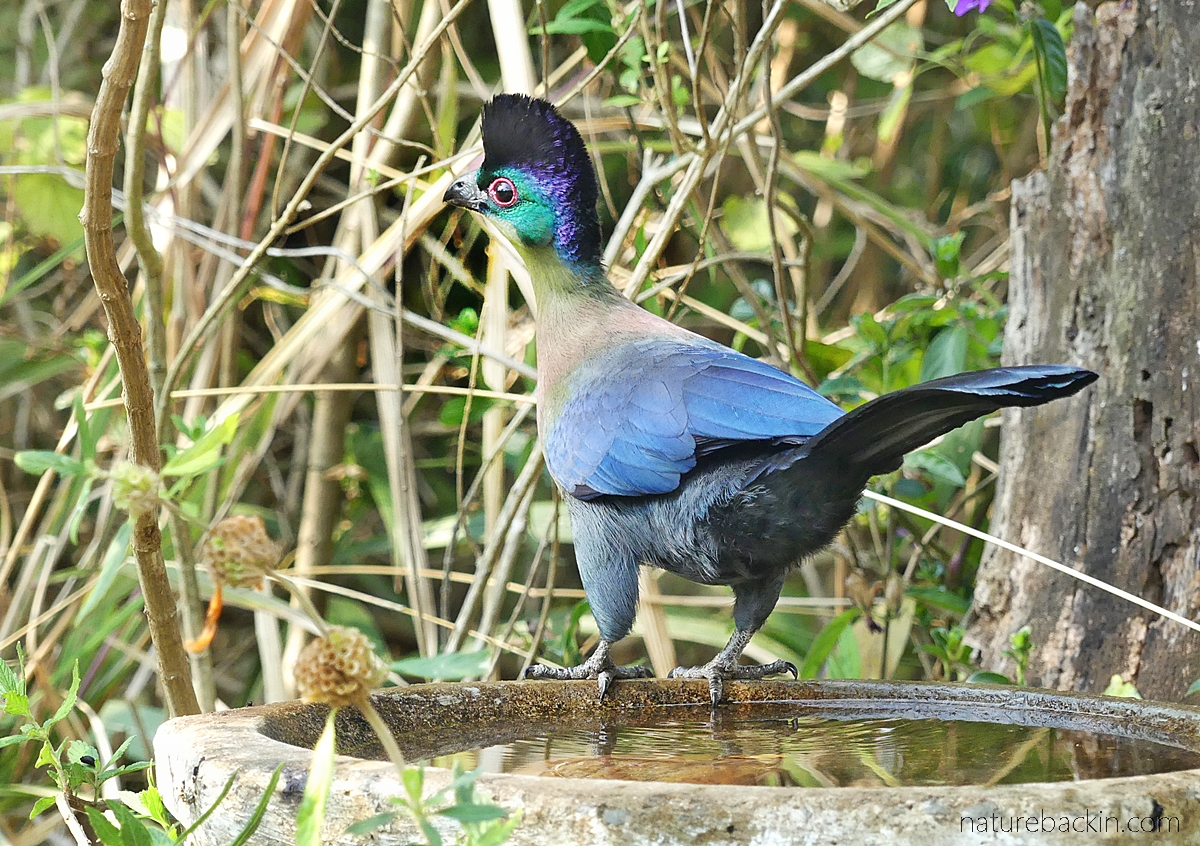
This is an unusual angle on a purple-crested turaco. They have a distinctive posture and way of moving with a strange agility as they creep and hop along tree branches when foraging. To hear their penetrating repetitive call, view the video in this previous post .

Usually mannikins visit in small flocks, lining the perimeter of the birdbath to drink. However, my ‘hide’ did not fool the cautious mannikins, and only one came down to drink while I was watching. Now this mannikin’s markings are unusual. It would be either a bronze or a red-backed mannikin, but the plumage of this bird is not typical of either, even for a juvenile. I wonder if anyone can identify this bird?

Perhaps the commonest visitors to the birdbaths are the very cute Cape white-eyes.
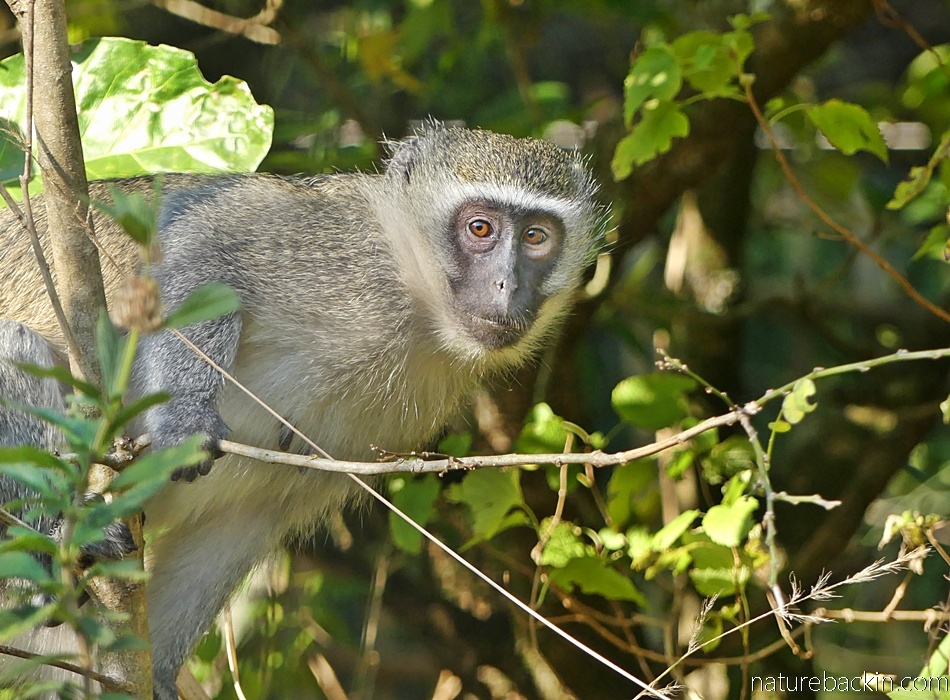
The Vervet monkeys also drink from the birdbaths. This female vervet has just noticed my camera peering through the ‘porthole’ in my fabric hide. This is the same monkey in the header photo in yesterday’s post. Because of her bemused expression I used the photo to illustrate the headline “Uh! Whaddya mean its Thursday already?”, but what she was most likely thinking was along the lines of “Uh! Why are you hiding and peering through that gap?”.

This is another monkey, having a drink from the birdbath in the bright morning sunshine while watching the lens of the camera. The monkeys tolerated me watching them better if I kept the camera up in front of my face preventing direct eye contact. Staring is not polite monkey etiquette.
Oddly enough, usually I am not in a ‘hide’ and the monkeys are used to seeing me around. But then they are uncomfortable if I lift the camera and point it at them, but the camera lens poking through a gap in the fabric appears to have a different effect.
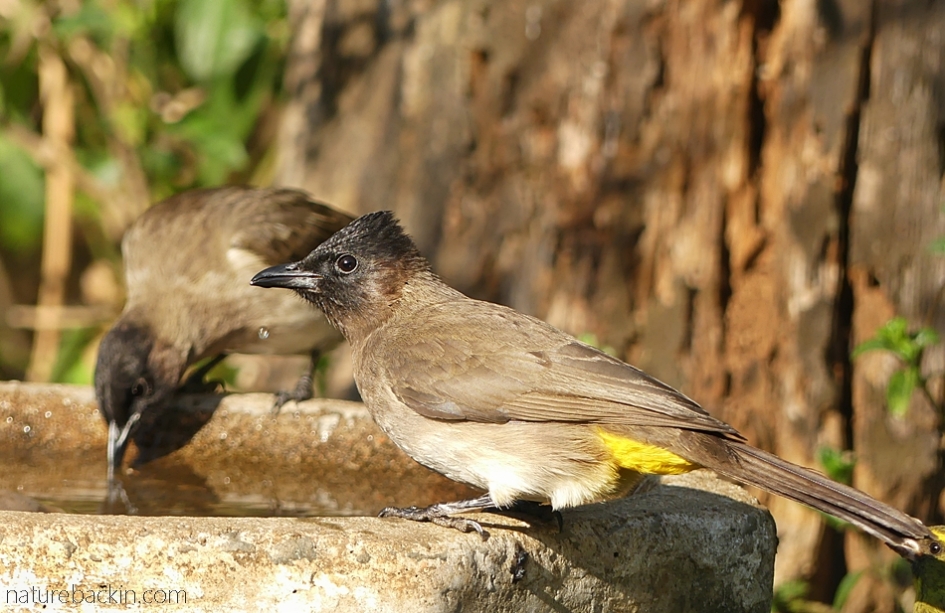
A pair of dark-capped-bulbuls enjoying a drink at the birdbath.

This dark-capped bulbul pauses on a stem before descending to drink at the birdbath.

On Wednesday I was thrilled to see this gorgeous black-headed oriole alighting on a stem above the birdbath. Unfortunately it decided not to drink this time, perhaps because of my presence, but the next day I did see it drinking, but I did not have the camera handy at the time.
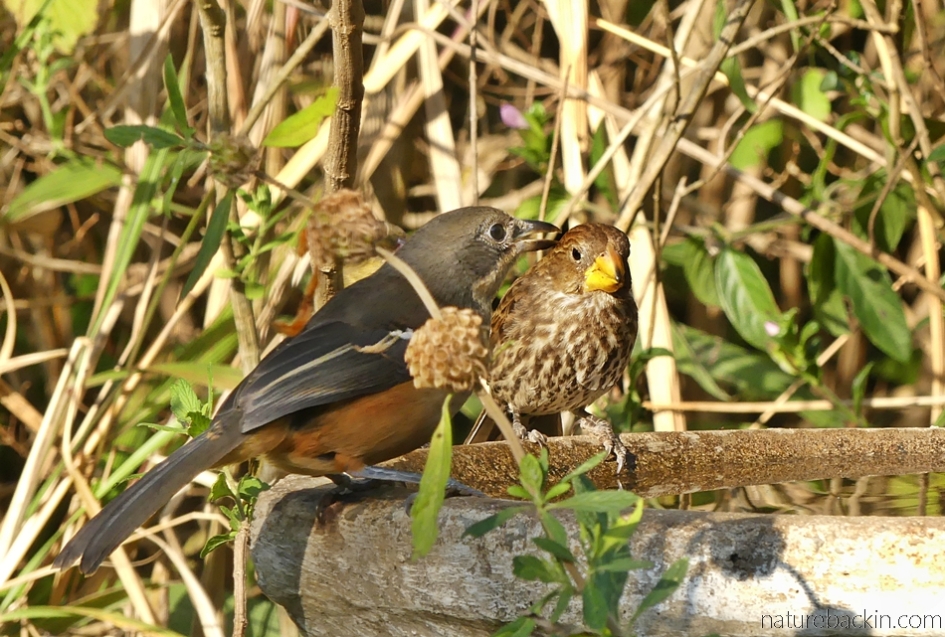
A female southern boubou approached the birdbath ‘on foot’ over quite a long distance along the ground. Most other birds arrive by flying in. No sooner had she got to the birdbath when a female thick-billed weaver arrived. The weaver was not the politest, at times leaning forward gaping her bill, but the boubou (on the left) pretended not to notice.

The two were joined by a dark-capped bulbul and the weaver moved along to the other side of the birdbath and proceeded to ‘pull faces’ at the bulbul that stood its ground.

Not putting up with that, the thick-billed weaver intensified its threat causing the bulbul to fly up and away. After that the weaver left too, leaving the boubou in peace until the arrival of a large red-eyed dove caused it too to move on.
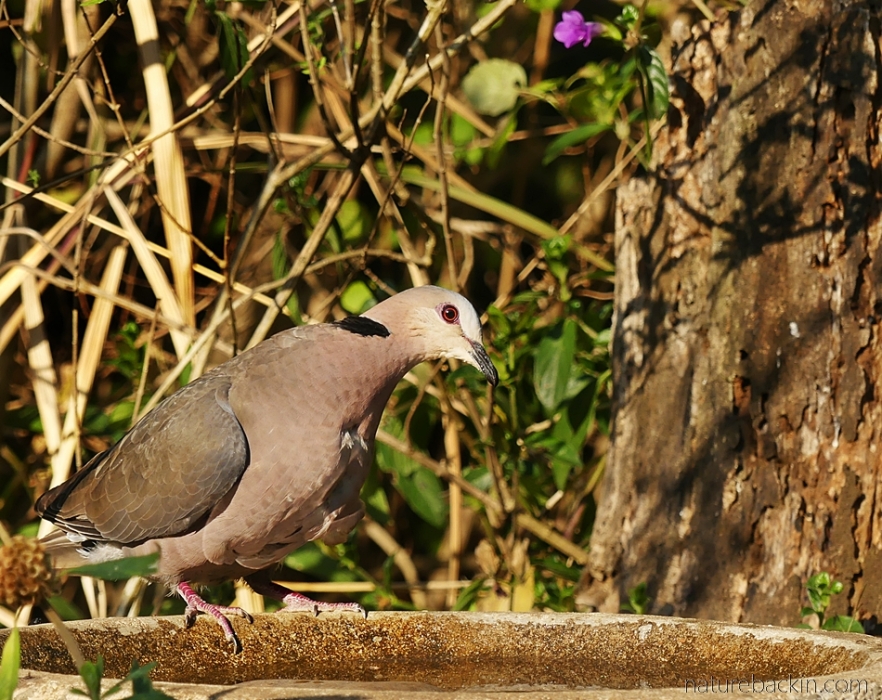
A red eyed dove at the birdbath. This one has rather dishevelled breast feathers, as if he has sustained a slight injury. For the past week he has been hanging out with a pair of red-eyed doves but frequently charging at them while they forage on the ground, sometimes bobbing his head and sometimes hopping energetically as he chases them. He is recognisable because of his tousled breast feathers and also because he is slightly darker than the other doves.

And to finish, a photo of another Cape white-eye.
Tomorrow, I will remove my temporary fabric hide from the fence, and resume watching the birds from our small front deck at a more comfortable distance.
Posted by Carol

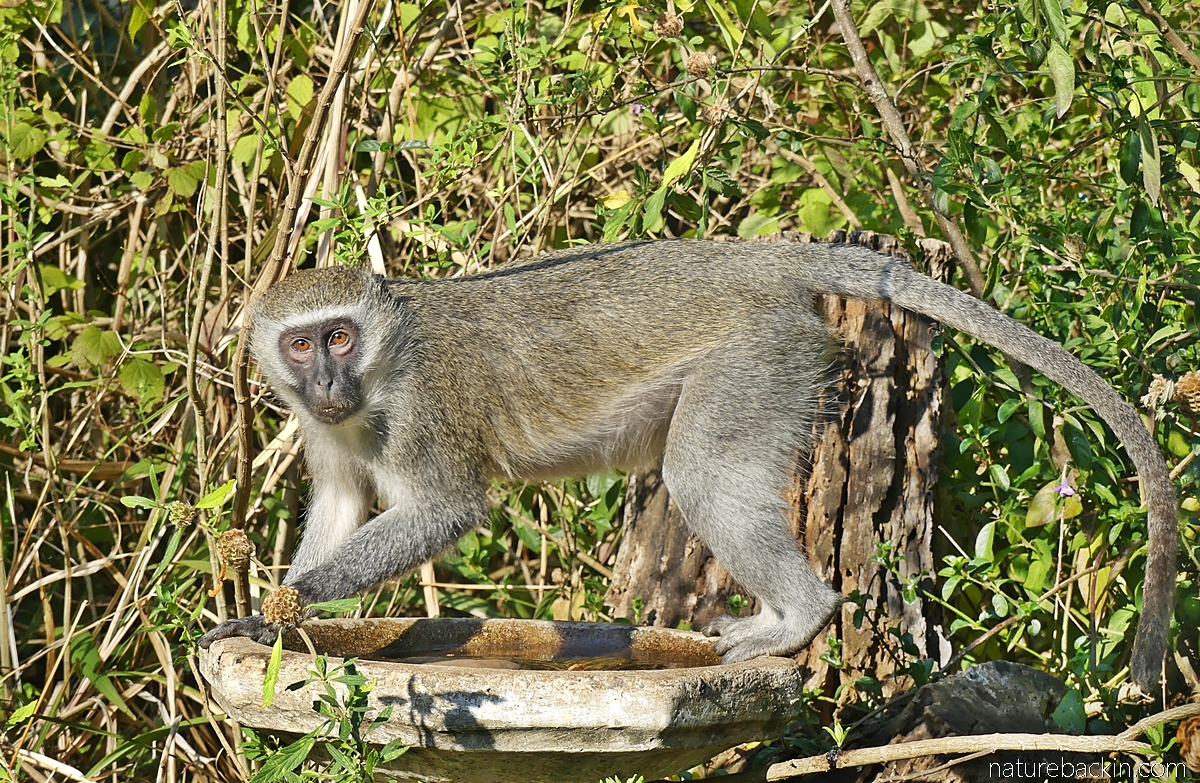







September 9, 2020 at 3:11 pm
These are really gorgeous bird photos. Thank you for sharing them with us.
LikeLiked by 1 person
September 10, 2020 at 2:52 pm
Thanks very much. A pleasure to share.
LikeLiked by 1 person
August 8, 2020 at 5:00 pm
That turaco is absolutely stunning. It must be interesting to have monkeys as regular visitors. No doubt very inquisitive ones.
Hope you’re keeping well.
LikeLike
August 14, 2020 at 12:00 pm
We enjoy the turacos visiting. A pair nest each year in a neighbour’s large tree. I grew up in this area and it is interesting that when I was a child they did not come this far inland. It is thought that climate change might be contributing to them expanding their range in from the coastal areas.
We also enjoy seeing the monkeys. They are incredibly observant and I am sure they know a lot more about us than we do about them!
We are well thanks and I hope that you are keeping well too.
LikeLiked by 1 person
July 29, 2020 at 8:53 pm
What delightful visitors you have. I’m particularly pleased that you included the link to the Purple-crested Turaco post. What a beautiful colorful bird and its call reminds me of something we’ve encountered in our travels, though memory fails to bring me the name.
LikeLiked by 1 person
July 30, 2020 at 8:57 pm
Yes our visitors are wonderful. I am glad you looked at the previous post on the turaco and saw the video of its call.
LikeLike
July 25, 2020 at 5:51 pm
These are wonderful photos of such a variety of birds+plus. The colors of the turaco are just remarkable. A bird I’ve never seen or heard of.
LikeLiked by 1 person
July 25, 2020 at 8:52 pm
Thanks very much. The turaco is remarkable and never seems to be entirely real!
LikeLiked by 1 person
July 25, 2020 at 4:30 pm
Carol, I hope at least some things are settling down in your neighbourhood now. It sounds like you’ve had a dramatic week. I hope that watching the birds from your cleverly-constructed bird hide was an opportunity for a little distraction from everything else. You certainly have some matvellous results to show for your efforts! I do love our British birds but they can’t compete with your garden visitors when it comes to colour!
LikeLiked by 1 person
July 25, 2020 at 8:51 pm
Watching the birds from the ‘hide’ was a really diverting distraction, thanks.
Birds everywhere are something to celebrate. When I was a child somebody gave me a book that was a guide to garden birds. It had lovely colour plates with beautifully painted images of birds. It took me some time to work out that it was a guide to British birds – and I grew up here in South Africa! What a Eurocentric gift! However, there were times during my childhood when I had extended stays in the UK – at least, thanks to that book, I was already familiar with many of the local birds 🙂
LikeLiked by 1 person
July 25, 2020 at 8:56 pm
Oh my goodness, eurocentric indeed! But it turned out to be useful as well as beautiful and hopefully the gift was kindly meant 😊
LikeLiked by 1 person
July 25, 2020 at 9:14 pm
Oh yes, I am sure it was well-intentioned and it was a lovely book and coloured (literally) my impressions of British birds even before I ever saw any 🙂
Btw thinking about the book has evoked another memory. Whenever my grandmother (my British grandmother) saw a magpie, she always said “Good morning/afternoon Mr or Mrs Magpie, whatever the case may be”. Something I simply took for granted at the time!
LikeLiked by 1 person
August 5, 2020 at 9:14 am
Carol, you may enjoy this article. I’ve never come across the practice of greeting a magpie before but your grandmother clearly had!
https://www.countrylife.co.uk/country-life/how-to-salute-a-magpie-70304
😊
LikeLiked by 1 person
August 5, 2020 at 5:53 pm
Thanks so much for the link to this article on how to greet a magpie and related superstitions. I was not aware of any of that. I wonder if the version my grandparents used wasn’t their own unique take on the greeting, given that from a distance one cannot be sure that a lone magpie is in fact a Mr!
LikeLiked by 1 person
August 5, 2020 at 5:58 pm
Yes indeed! I think all such folklore and superstitions will vary by region too. We have many magpies here. I’m watching now for lone birds. Usually there is another one close by but just occasionally one seems to be alone. I greet it in my thoughts, mindful now of keeping the old folklore alive 😊
LikeLiked by 1 person
August 5, 2020 at 6:10 pm
Yes my grandparents’ variation may have been regional rather than unique to the family.
Even though magpies were/are not necessarily highly though of, greeting the solitary birds is a rather charming observance and how nice that you are now mindful of the old custom.
I wish now I had kept more of a record of the old words and country traditions my grandparents used or observed.
LikeLiked by 1 person
July 25, 2020 at 2:36 pm
Who needs Netflix when you have a birdbirth?! Thank you for this enchanting set of photographs. It was especially transfixing to see a Touraco so closley
LikeLiked by 1 person
July 25, 2020 at 8:31 pm
It certainly was most entertaining watching the goings on between birds at the birdbath.
The purple-crested turaco never ceases to amaze …
LikeLike
July 26, 2020 at 8:09 am
They are strange birds. We sometimes see the Knysna turaco frolicking in the Hogsback birdbath. The sight always makes me gasp and chuckle
LikeLiked by 1 person
July 26, 2020 at 3:47 pm
They are strange. The Knysna loerie, sorry turaco, has a more ethereal beauty compared to the purple-crested, although it too has a definite robustness about it. And yes, gasp and chuckle are appropriate responses!
LikeLiked by 1 person
July 25, 2020 at 12:25 pm
Beautiful photos, especially of the purple crested lourie. And what an excellent photo of the pecking order at the birdbath!
LikeLiked by 1 person
July 25, 2020 at 8:29 pm
Thanks very much. The pecking order appears to be quite volatile!
LikeLiked by 1 person
July 29, 2020 at 7:32 am
Birds are such funny creatures!
LikeLiked by 1 person
July 25, 2020 at 6:32 am
I feel complete: watching visitors to one of our birdbaths is a favourite occupation of mine – seldom with a camera in hand though for they tend to fly off upon hearing the ‘click’. You have captured these interactions very well. Funnily enough, I see our Black-headed Oriole at the nectar feeder and very seldom at a bird bath.
LikeLiked by 1 person
July 25, 2020 at 8:12 pm
Most cameras have a setting where you can reduce the volume of the “shutter click”, or even disable the sound altogether. It might be worth a try?
We don’t have a nectar feeder – there seem to be nectar-providing flowers of one sort or another all year round. I seldom see the orioles at the bird bath, but it is nice to know that they do make use of it from time to time.
LikeLike
July 26, 2020 at 4:46 am
Thank you, I will investigate.
LikeLiked by 1 person
July 25, 2020 at 6:07 am
Great variety of life at your bird bath. I’d be tempted to keep the hide. I hope things have settled down in your part of the world and the fire is out.
LikeLiked by 1 person
July 25, 2020 at 8:04 pm
Thanks Graham. We are thinking of making a small ‘A-frame’ portable hide.
The fire is still burning but a lot less intensely, and they hope to get it out over the next few days.
LikeLike
July 25, 2020 at 5:11 am
Oh what a clever thing to do! I love the Oriole, and as for the politics round the bird bath – too precious! Thank you for sharing Carol loved this.
LikeLiked by 1 person
July 25, 2020 at 8:03 pm
Thanks Carol – it was an enjoyable experiment, and the cats enjoyed it too. One of them sat behind the fabric with me and watched the birds through the rather dense weave of the black fabric I used to make the ‘hide’. The birds seem to have figured out that the weld-mesh fence of the cat garden forms a safe barrier.
LikeLike
July 25, 2020 at 5:09 am
Your bird bath visitors seem wonderfully exotic to British eyes, Carol. And extremely varied, though of course with patience we see variety too. Note to self. Rig up a hide!
LikeLiked by 1 person
July 25, 2020 at 7:59 pm
Some of the birds visiting here are fairly spectacular, which is not to say that the more subtly coloured birds are not beautiful too.
Rigging up a little bird hide will be an interesting experiment. I have read about a bird photographer who goes about dressed essentially as a small tent in camouflage colours 🙂
LikeLiked by 1 person
July 26, 2020 at 7:16 am
That must amuse the birds, who doubtless are not fooled one bit!
LikeLiked by 1 person
July 25, 2020 at 4:25 am
Your ingenious hide design has certainly paid off in wagon-loads, Carol – what a beautiful feast!
Owing to the dark bill I’d say the Mannikin is a “teenage” Bronze Mannikin in the midst of growing into its adult plumage.
And that female Thick-billed Weaver needs to be careful – wanting to drink alone is never a good sign…
LikeLiked by 1 person
July 25, 2020 at 7:50 pm
Thanks for the mannikin ID.
You make a good point re the thick-billed weaver and the dangers inherent in her anti-social tendencies when drinking 🙂
LikeLiked by 1 person
July 25, 2020 at 3:56 am
I just love the winter visitors to our birdbaths and your post is perfect Carol. The only difference is our birds all take a dip, even in the early morning….. xxxx
LikeLiked by 1 person
July 25, 2020 at 7:42 pm
I am wondering why so few of the visiting birds actually bathed in the birdbath. Of the birds featured in the blog post, only one – a male village weaver -took a dip.
LikeLike
July 25, 2020 at 3:36 am
It’s wonderful to see your winged visitors, Carol. They are so different from our
feathered friends.
LikeLiked by 1 person
July 25, 2020 at 7:39 pm
Thanks Sandy. We do have a surprising diversity of visiting birds here.
LikeLiked by 1 person
July 25, 2020 at 8:18 pm
Welcome!
LikeLiked by 1 person
July 25, 2020 at 3:03 am
Hello Carol,
What a busy day it has been in your garden! This really made my day. Thank you.
Hope you and all your dear ones continue to stay safe and well.
LikeLiked by 1 person
July 25, 2020 at 7:38 pm
Hi Takami. It surprised me how busy the birdbath has been this week.
We are fine thank you, and I hope that you and yours are keeping safe too. Best wishes.
LikeLiked by 1 person
July 25, 2020 at 2:01 am
These are wonderful images, Carol. So clear and sharp, I love seeing the details of each bird.
LikeLiked by 1 person
July 25, 2020 at 7:37 pm
Thanks Eliza. Watching the birds coming to drink is an excellent diversion.
LikeLiked by 1 person